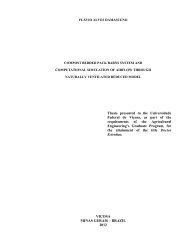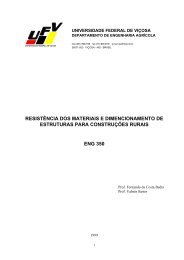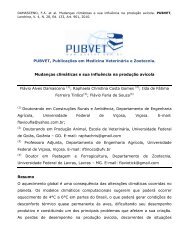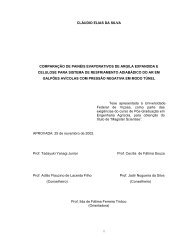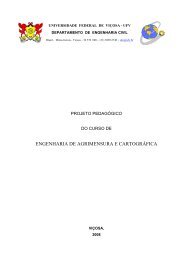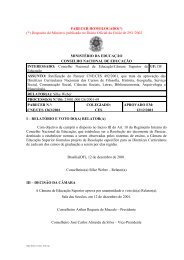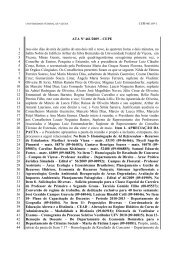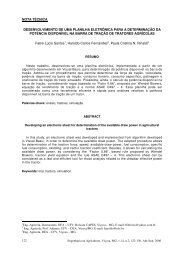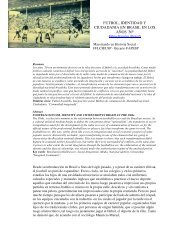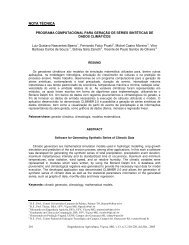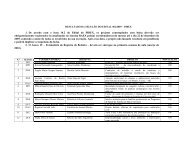ALKALOID BIOSYNTHESIS IN PLANTS: Biochemistry, Cell ... - UFV
ALKALOID BIOSYNTHESIS IN PLANTS: Biochemistry, Cell ... - UFV
ALKALOID BIOSYNTHESIS IN PLANTS: Biochemistry, Cell ... - UFV
Create successful ePaper yourself
Turn your PDF publications into a flip-book with our unique Google optimized e-Paper software.
54 FACCH<strong>IN</strong>I<br />
levels in transgenic P. harmala cell cultures with elevated heterologous TDC activity<br />
were ten- to 20-fold higher than in control cultures (13). In contrast, βcarboline<br />
alkaloid levels were not affected, demonstrating that tryptamine supply<br />
is limiting for serotonin, but not for β-carboline alkaloid, biosynthesis. The mechanism<br />
for the metabolic channeling of tryptophan into serotonin and β-carboline<br />
alkaloids in P. harmala is not known. It is possible that two TDC isoforms<br />
occur in separate subcellular locations, and the additional tryptamine produced<br />
in transgenic cultures is available to only one pathway.<br />
The metabolic engineering of BIA pathways has not been reported owing to the<br />
previous lack of transformation protocols for BIA-producing plants. However, procedures<br />
have recently been developed for the transformation of opium poppy plants<br />
(128), root cultures (129), and cell cultures (12), and E. californica plants (127)<br />
and root cultures (129). These transformation systems provide the opportunity to<br />
alter the activity of individual enzymes of BIA biosynthesis, and to examine the<br />
consequences of such modifications on the accumulation of end-products and pathway<br />
intermediates. Efficient transformation protocols for these species will also<br />
facilitate progress in dissecting the molecular regulation of BIA biosynthetic genes.<br />
Other Uses of Alkaloid Biosynthetic Genes<br />
in Genetic Engineering<br />
Enzymes that operate at the interface between amino acid and alkaloid metabolism<br />
have been used to alter substrate and product pools in a variety of plants. These<br />
studies provide insight into the control architecture of amino acid biosynthesis<br />
and relevant physiological processes. Tryptamine accumulation in tobacco<br />
plants expressing heterologous TDC was proportional to the level of TDC activity<br />
(60, 134, 155). Remarkably, plant growth was not affected despite the creation<br />
of a large sink for tryptophan and a large pool of soluble tryptamine. Moreover,<br />
no significant difference was detected in the activity of key aromatic amino acid<br />
biosynthetic enzymes (134), and IAA levels were identical in high-tryptamine and<br />
control plants (155). Transformed tobacco expressing TDC was also reported to<br />
accumulate more tyramine compared to controls (156). The most plausible explanation<br />
for this result is that the increased demand for tryptophan up-regulates the<br />
shikimate pathway resulting in increased tyrosine biosynthesis and, consequently,<br />
higher tyramine production via an endogenous TYDC activity.<br />
Introduction of TDC into Brassica napus (canola) resulted in the redirection<br />
of tryptophan into tryptamine rather than indole glucosinolates (20). The indole<br />
glucosinolate content of seeds from transgenic plants was only 3% of that in wildtype<br />
seeds. In oilseeds, such as canola, the presence of indole glucosinolates<br />
decreases the value of the seed meal as an animal feed. This study is an elegant<br />
example of how a gene normally operating at an entry point in alkaloid biosynthesis<br />
can be used to divert metabolic flow and reduce undesirable product levels in crop<br />
species. In contrast, the introduction of TDC into potato altered the balance of



